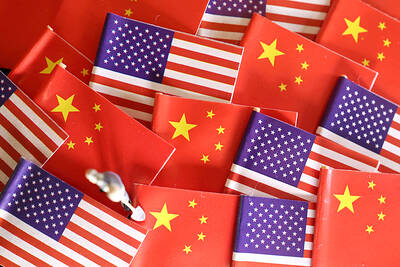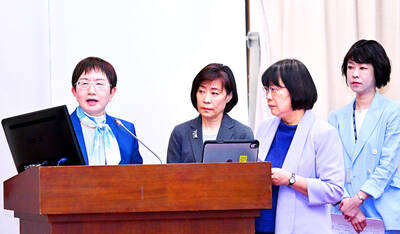Taiwan’s five major convenience store chains had a total of 9,204 outlets nationwide at the end of last year, giving it the highest density of convenience stores in the world, with each store serving 2,500 people, the Fair Trade Commission said yesterday.
Of the total number of stores, 14.3 percent were company-owned outlets, while franchise stores accounted for 85.7 percent of the total, the commission’s tallies showed.
The commission attributed the large number of franchise stores to the relatively low cost and low investment risk.
President Chain Store Corp’s (統一超商) 7-Eleven had the largest market share, with 4,800 outlets last year, followed by Taiwan FamilyMart Co (全家便利商店), the country’s second-largest convenience store chain with 2,324 outlets.
This was followed by Hi-Life International Co (萊爾富) with 1,236 stores, OK Mart Co’s (來來超商) 824 convenience stores and 20 stores operated by Taiwan Sugar Corp (台糖), the survey found.
The number of new convenience stores declined, with the growth rate falling to 1.47 percent last year from 25.38 percent recorded in 1999, mainly because of economic sluggishness, store mergers and emerging market saturation, the commission said.
The number of convenience stores nationwide saw a record-high net increase of 1,002 in 1999, which had fallen to 133 by last year, the commission’s tallies showed.
The commission said that despite market saturation, there was still room for expansion, as the five chains still reported net increases in their store numbers last year.
Separately, the Executive Yuan yesterday approved a service industry development program aimed at boosting the industry’s GDP to NT$11 trillion (US$333.8 billion) by 2012 and its exports to 1.2 percent of the global total by the same year.
The Council for Economic Planning and Development, which drafted the plan, said in a report submitted to a Cabinet meeting yesterday that a lack of simulation abilities made Taiwan’s service industry import-centered rather than export-oriented.
Last year, the export value of the industry stood at US$33.8 billion, which accounted for 0.9 percent of the global total and ranked 28th in the world.
In 2007, the sector’s R&D spending was less than 0.2 percent of its GDP, far lower than the 7 percent recorded in the manufacturing sector, the council said.
The council said that more should be spent in this area to boost the sector’s international competitiveness, improve R&D and innovation performance, create platforms for differentiated services, strengthen talent recruitment and nurture development potential.
The government should guide domestic service providers toward tapping overseas markets and help them overcome barriers to market access by lifting and easing regulations and restrictions, it said.

‘SWASTICAR’: Tesla CEO Elon Musk’s close association with Donald Trump has prompted opponents to brand him a ‘Nazi’ and resulted in a dramatic drop in sales Demonstrators descended on Tesla Inc dealerships across the US, and in Europe and Canada on Saturday to protest company chief Elon Musk, who has amassed extraordinary power as a top adviser to US President Donald Trump. Waving signs with messages such as “Musk is stealing our money” and “Reclaim our country,” the protests largely took place peacefully following fiery episodes of vandalism on Tesla vehicles, dealerships and other facilities in recent weeks that US officials have denounced as terrorism. Hundreds rallied on Saturday outside the Tesla dealership in Manhattan. Some blasted Musk, the world’s richest man, while others demanded the shuttering of his

ADVERSARIES: The new list includes 11 entities in China and one in Taiwan, which is a local branch of Chinese cloud computing firm Inspur Group The US added dozens of entities to a trade blacklist on Tuesday, the US Department of Commerce said, in part to disrupt Beijing’s artificial intelligence (AI) and advanced computing capabilities. The action affects 80 entities from countries including China, the United Arab Emirates and Iran, with the commerce department citing their “activities contrary to US national security and foreign policy.” Those added to the “entity list” are restricted from obtaining US items and technologies without government authorization. “We will not allow adversaries to exploit American technology to bolster their own militaries and threaten American lives,” US Secretary of Commerce Howard Lutnick said. The entities

Minister of Finance Chuang Tsui-yun (莊翠雲) yesterday told lawmakers that she “would not speculate,” but a “response plan” has been prepared in case Taiwan is targeted by US President Donald Trump’s reciprocal tariffs, which are to be announced on Wednesday next week. The Trump administration, including US Secretary of the Treasury Scott Bessent, has said that much of the proposed reciprocal tariffs would focus on the 15 countries that have the highest trade surpluses with the US. Bessent has referred to those countries as the “dirty 15,” but has not named them. Last year, Taiwan’s US$73.9 billion trade surplus with the US

Prices of gasoline and diesel products at domestic gas stations are to fall NT$0.2 and NT$0.1 per liter respectively this week, even though international crude oil prices rose last week, CPC Corp, Taiwan (台灣中油) and Formosa Petrochemical Corp (台塑石化) said yesterday. International crude oil prices continued rising last week, as the US Energy Information Administration reported a larger-than-expected drop in US commercial crude oil inventories, CPC said in a statement. Based on the company’s floating oil price formula, the cost of crude oil rose 2.38 percent last week from a week earlier, it said. News that US President Donald Trump plans a “secondary